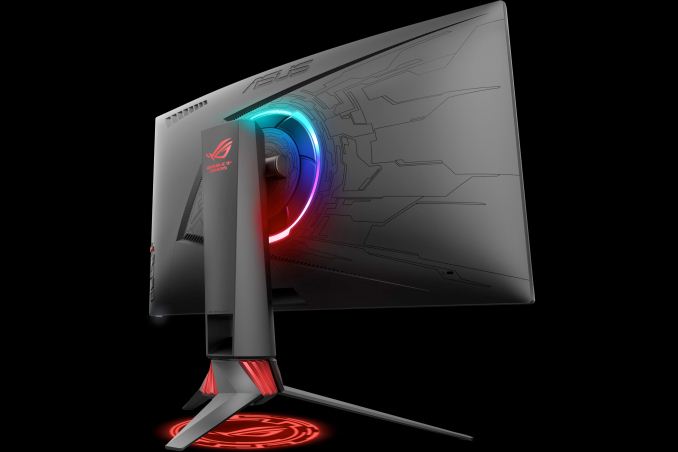ASUS Unveils Three Strix Gaming Monitors: FreeSync & High Refresh Rates
by Patrick MacMillan on June 6, 2017 11:00 AM EST
Hot on the heels of the Swift PG35VQ announcement, ASUS has unveiled three new Strix-branded gaming monitors that will feature AMD’s FreeSync technology. While the first Strix model was unveiled back at CES 2017 - the Strix XG27VQ - it was a one-off until the announcement of these newest models. Clearly, ASUS intends to have a gaming monitor lineup that consists of both the Strix and Swift series.
Starting off from largest to smallest, we have the Strix XG32V. This model has a 31.5-inch IPS panel with a WQHD resolution of 2560 × 1440 and an 1800R curve that should help provide a wider field of view. We don't have a ton of other technical details, we do know that this model can handle refresh rates of up to 144Hz and it supports FreeSync. It will be interesting to see what the actual FreeSync range actually is.
For connectivity, there are two DisplayPort 1.2 inputs, one HDMI 2.0 input, and an undisclosed amount of USB 3.0 ports. Like on many of their other new gaming-oriented monitors, ASUS has added Aura Sync lighting to the XG32V. This not only means there will be an ROG logo that shines down onto the desk, but a back panel that features RGB LEDs and that can be synchronized with other Aura Sync-enabled PC components and peripherals.
Moving on to the next monitor, the Strix XG27V is a more value-minded model that shares the 1800R curvature of the XG32GV, but shrinks the panel down to 27 inches and the resolution to 1920 x 1080. Thankfully, this model can handle refresh rates of up to 144Hz and it also supports FreeSync.
While the XG27V has onboard Aura RGB lighting, it doesn't have Aura Sync, so it cannot synchronize with other Aura-compatible components and peripherals. Although specifics are lacking, connectivity is the form of a DisplayPort input, an HDMI input, and DVI-D port.
While the Strix XG258 might be the smallest of the bunch, it has an ace up its sleeve. This 24.5-inch display features a 1920 x 1080, which is pretty conventional, but it supports a maximum refresh rate of up to 240Hz. According to ASUS, this means that the delay between new frames is just 4.2 ms, compared to 6.9 ms on a 144Hz gaming monitor.
Much like the XG27V, this model has onboard Aura RGB lighting, but it doesn't have Aura Sync, so it cannot synchronize with other Aura-compatible components and peripherals. For connectivity, there are two DisplayPort 1.2 and two HDMI inputs, one of which is HDMI 2.0.
Although we have no pricing details, all of these new Strix gaming monitors will be available starting in Q3.
Source: ASUS











16 Comments
View All Comments
0siris - Tuesday, June 6, 2017 - link
@Patrick MacMillanDid you get any information about the strobing on the monitors? ASUS referred to them as "Extreme Low Motion Blur" in their press release, so I'm wondering if this means something beyond the normal 120Hz strobing modes we've had for years. In particular, I'm wondering if XG258 will have a ~180Hz strobed mode that is factory calibrated to avoid crosstalk. Thank you in advance.
JoeyJoJo123 - Wednesday, June 7, 2017 - link
It's unlikely. ULMB isn't a "thing" on FreeSync monitors, as ULMB is categorically an improvement to Nvidia's Lightboost and is a feature defined by Nvidia to coincide side-by-side Gsync on Gsync enabled monitors. FreeSync monitors aren't Gsync enabled, and therefore don't have ULMB.http://www.144hzmonitors.com/g-sync-ulmb/
Extreme Low Motion Blur is likely an AMD equivalent that ASUS has created to coincide with FreeSync, in absence of AMD FreeSync monitors having any ULMB option.
Furthermore, as you already know ULMB is defined at 120hz. If you're interested in 180hz "ULMB" + Freesync, it's possible that the XL2540 (24.5" 240hz 1080p TN FreeSync) might be able to adjust for that, but I can't make any guarantees. Essentially you'd set that monitor at that refresh rate, then run the strobe utility and adjust the settings until the image is tuned for the refresh rate you want, and it's done.
https://www.blurbusters.com/benq/strobe-utility/
Unlike other "ULMB" modes shipped by other monitor manufacturers, BenQ/Zowie has both a custom implementation that allows for adjustment of the strobe phase, strobe duty, and single strobing, so you can adjust the trade-off between reduced input lag versus reduced ghosting.
0siris - Wednesday, June 7, 2017 - link
I am aware, but seeing as they used a new term for it(which you could be absolutely right in saying is just their new name for the Freesync equivalent of ULMB) I was hoping they might have taken note of the community experimentation that's been going on with the XL2540 and XL2546 and decided to include an out-of-the-box menu setting for it on the XG258. I mean... someone has got to do it at some point, right? That would be a lot more appealing to the general consumer than "go fiddle with your refresh rate and vertical totals for half an hour until it looks right".Samus - Wednesday, June 7, 2017 - link
How hard is it to make a monitor that just looks like a monitor. What the hell is going on with that styling?TEAMSWITCHER - Wednesday, June 7, 2017 - link
Ugly.vision33r - Wednesday, June 7, 2017 - link
Freesync is a must have today and G-sync is great too. I think the dilemma is that AMD GPUs just aren't competitive today and hard to find. So it's better just to pay for the higher priced G-sync monitors and pair with Nvidia GPUs. I've gamed on several G-syncs and just super stable and lag free gaming at 4K. How could anyone game without it.